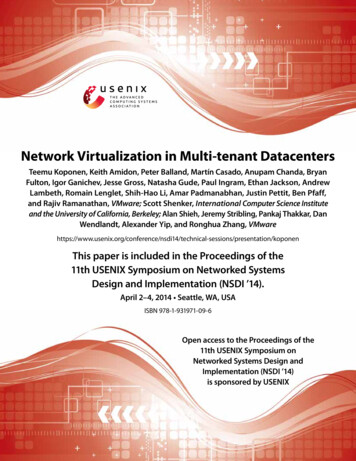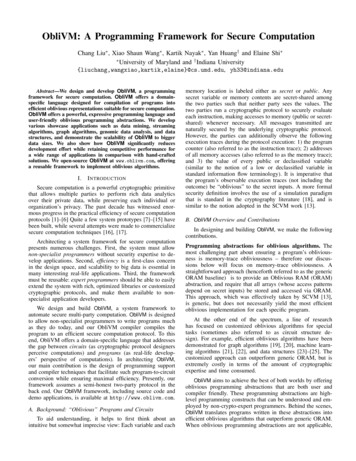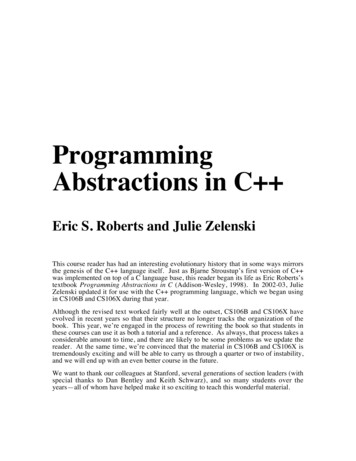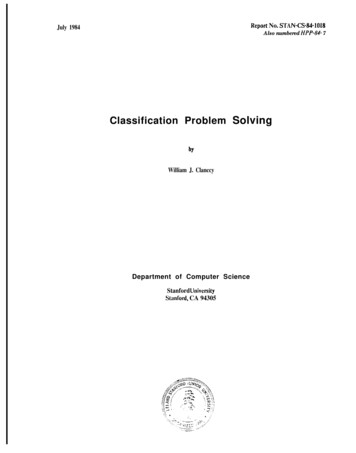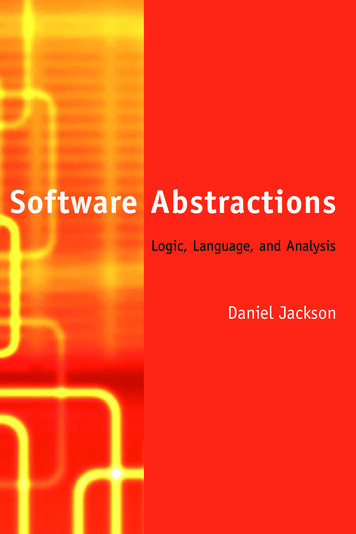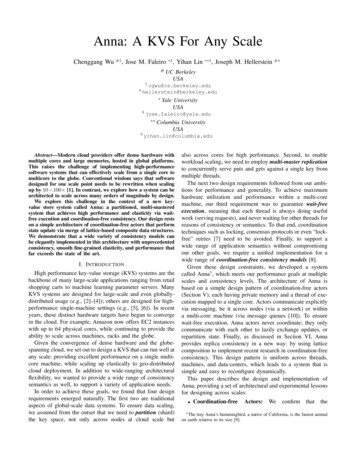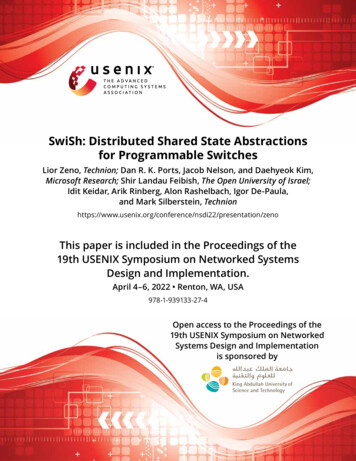
Transcription
SwiSh: Distributed Shared State Abstractionsfor Programmable SwitchesLior Zeno, Technion; Dan R. K. Ports, Jacob Nelson, and Daehyeok Kim,Microsoft Research; Shir Landau Feibish, The Open University of Israel;Idit Keidar, Arik Rinberg, Alon Rashelbach, Igor De-Paula,and Mark Silberstein, resentation/zenoThis paper is included in the Proceedings of the19th USENIX Symposium on Networked SystemsDesign and Implementation.April 4–6, 2022 Renton, WA, USA978-1-939133-27-4Open access to the Proceedings of the19th USENIX Symposium on NetworkedSystems Design and Implementationis sponsored by
SwiSh: Distributed Shared State Abstractions for Programmable SwitchesLior Zeno Dan R. K. Ports† Jacob Nelson† Daehyeok Kim† Shir Landau Feibish‡Arik Rinberg Alon Rashelbach Igor De-Paula Mark Silberstein Technion† MicrosoftResearchAbstractWe design and evaluate SwiSh, a distributed shared state management layer for data-plane P4 programs. SwiSh enablesrunning scalable stateful distributed network functions on programmable switches entirely in the data-plane. We exploreseveral schemes to build a shared variable abstraction, whichdiffer in consistency, performance, and in-switch implementation complexity. We introduce the novel Strong DelayedWrites (SDW) protocol which offers consistent snapshots ofshared data-plane objects with semantics known as 𝑟-relaxedstrong linearizability, enabling implementation of distributedconcurrent sketches with precise error bounds.We implement strong, eventual, and SDW consistency protocols in Tofino switches, and compare their performance inmicrobenchmarks and three realistic network functions, NAT,DDoS detector, and rate limiter. Our results show that thedistributed state management in the data plane is practical,and outperforms centralized solutions by up to four orders ofmagnitude in update throughput and replication latency.1IntroductionIn recent years, programmable data-plane switches suchas Intel’s Tofino, Broadcom’s Trident, and NVIDIA’s Spectrum [9, 33, 60] have emerged as a powerful platform forpacket processing, capable of running complex user-definedfunctionality at Tbps rates. Recent research has shown thatthese switches can run sophisticated network functions (NFs)that power modern cloud networks, such as NATs, load balancers [40, 57], and DDoS detectors [45]. Such data-planeimplementations show great promise for cloud operators, asprogrammable switches can operate at orders of magnitudehigher throughput levels than the server-based implementations used today, enabling a massive efficiency improvement.A key challenge remains largely unaddressed: realistic datacenter deployments require NFs to be distributed over multiple switches. Multi-switch execution is essential to correctlyprocess traffic that passes through multiple network paths,USENIX Association‡ TheIdit Keidar Open University of Israelto tolerate switch failures, and to handle higher throughput.Yet, building distributed NFs for programmable switches ischallenging because most of today’s NFs are stateful and needtheir state to be consistent and reliable. For example, a DDoSdetector may need to monitor traffic coming from multiplelocations via several switches. However, it cannot be implemented by routing all traffic through a single switch since itis inherently not scalable. Instead, it must be implemented ina distributed manner. Furthermore, in order to detect and mitigate an attack, a DDoS detector must aggregate per-packetsource statistics across all switches in order to correctly identify super-spreaders sending to too many destinations. Similarly, in multi-tenant clouds, per-user policies, such as ratelimiting, cannot be implemented in a single switch becauseuser’s VMs are often scattered across multiple racks, so theinter-VM traffic passes through multiple switches.Distributed state management is, in general, a hard problem, and it becomes even harder in the context of programmable data-plane switches. In the “traditional” hostbased NF realm, several methods have been proposed to dealwith distributed state. These include remote access to centralized state storage [39] and distributed object abstractions [77],along with checkpoints and replication mechanisms for faulttolerance [64, 71]. Unfortunately, few of these techniquestransfer directly to the programmable switch environment.These switches have the capability to modify state on everypacket, allowing them to effectively implement stateful NFs.However, distributing the NF logic across multiple switchesis extremely challenging as it requires synchronizing thesefrequent changes under harsh restrictions on computation,memory and communication.Existing systems that implement NFs over multipleswitches do so by designing ad hoc, application-specific protocols. Recent work on data-plane defense against link flooding [36], argues for data-plane state synchronization amongthe switches, but provides no consistency guarantees. Whileapplicable in this scenario, it would not be enough in otherapplications, as we discuss in our analysis (§4). A more common solution, usually applied in network telemetry systems,19th USENIX Symposium on Networked Systems Design and Implementation171
is to periodically report the per-switch state to a central controller [1,6,18,25,26,29,49,78]. Such systems need to managethe state kept on each switch and to determine when and howthe central controller is updated – navigating complex tradeoffs between frequent updates leading to controller load andcommunication overhead versus stale data leading to measurement error. In contrast to these approaches, we seek a solutionthat supports general application scenarios without relying ona central controller in failure-free runs, while allowing allswitches to take a consistent action as a function of the globalstate, e.g., to block a suspicious source in the DDoS detector.We describe the design of such a general distributed sharedstate mechanism for data-plane programs, SwiSh. Inspiredby distributed shared memory abstractions for distributed systems [41, 48], SwiSh provides several replicated shared variable abstractions with different consistency guarantees. Atthe same time, SwiSh is tailored to the needs of NFs andco-designed to work in a constrained programmable switchenvironment.Our analysis reveals three families of NFs that lend themselves to efficient in-switch implementation, with distinctconsistency requirements. For each family we explore thetriple tradeoff between consistency, performance, and complexity. We design (1) Strong Read-Optimized (SRO): astrongly consistent variable for read-intensive applicationswith low update rates, (2) Eventual Write-Optimized (EWO):an eventually-consistent variable for applications that can tolerate inconsistent reads but require frequent writes, and (3)Strong Delayed-Writes (SDW): a novel consistency protocol which efficiently synchronizes multi-variable snapshotsacross switches while providing a consistency and correctnessguarantee known as 𝑟-relaxed strong linearizability [27].SDW is ideal for implementing concurrent sketches, whichare popular in data-plane programs [12, 13, 24, 30, 35, 38,51–54, 78, 83]. Unlike eventually consistent semantics, the𝑟-relaxed strong linearizability offered by SDW enables principled analysis of concurrent sketches. This property enablesthe derivation of precise error bounds and generalizes to different sketch types, such as non-commutative sketches [67].Implementing these abstractions efficiently in a switch isa challenge, and it involves judicious choice of hardwaremechanisms and optimization targets. Our main ideas are: (1)minimizing the buffer space due to the scarcity of switch memory, even at the expense of higher bandwidth; (2) using thein-switch packet generator for implementing reliable packetdelivery and synchronization in the data-plane.We fully implement all the protocols in Tofino switchesand devise reusable APIs for data-plane replication. We evaluate the protocols both in micro-benchmarks and in threereal-world distributed NFs: a rate limiter, a network addresstranslator (NAT) and a DDoS detector. Our novel SDW protocol achieves micro-second synchronization latency and offersabout four orders of magnitude higher update rates comparedto a central controller or SRO. We show that SDW (1) achieves172stable 99th percentile replication latency of 6𝜇sec when running on four programmable pipes (two per switch), thus sharing state both among local and remote pipes; (2) scales to32 switches when executed in a large-scale emulation andfits switch resources even for 4K switches; (3) requires linear number of replication messages in state size which isindependent from the number of actual updates to the state.We show that SDW is instrumental to achieving high performance in applications: the centralized controller fails toscale under growing application load, whereas SDW-basedversions show no signs of performance degradation.This paper extends our workshop paper [82] by introducingthe SDW protocol, as well as providing an implementationand evaluation of SRO and EWO.In summary, this work makes the following contributions: Analysis of memory consistency requirements and accesspatterns of common NFs suitable for in-switch execution, Design and implementation of strongly- and eventually consistent shared variables, as well as a new SDW consistencyprotocol specifically tailored for in-switch implementation,which guarantees consistent snapshots and provably provides 𝑟-relaxed strong linearizability which facilitates implementation of concurrent sketches, An implementation and evaluation of three distributed NFson Tofino switches demonstrating the practicality and utilityof the new abstractions.2Background: Programmable SwitchesThe protocol independent switch architecture (PISA) [8] defines two main parts to packet processing. The first is theparser which parses relevant packet headers, and the secondis a pipeline of match-and-action stages. Parsed headers andmetadata are then processed by the pipeline. The small ( 10MB) switch memory is shared by all pipeline stages. Often,switches are divided into multiple independent pipes [34],each serving a subset of switch ports. From the perspective ofin-switch applications, the pipes appear as different switches,so stateful objects are not shared between them.PISA-compliant devices can be programmed using the P4language [73]. P4 defines a set of high-level objects that consume switch memory: tables, registers, meters, and counters.While tables updates require control-plane involvement, allother objects can be modified directly from the data-plane.A data-plane program processes packets, and then can sendthem to remote destinations to the control-plane processor onthe switch, or to the switch itself (called recirculation).Switches process packets atomically: a packet may generate several local writes to different locations, and these updates are atomic in the sense that the next processed packetwill not see partial updates. Single-row control-plane tableupdates are atomic w.r.t. data-plane [74]. These propertiesallow us to implement complex distributed protocols withconcurrent state updates without locks.19th USENIX Symposium on Networked Systems Design and ImplementationUSENIX Association
Although not a part of PISA, some switches add packetgeneration support. Packet generators can generate packetsdirectly into the data-plane. For example, the Tofino NativeArchitecture (TNA) [34] allows generation of up to 8 streamsof packets based on templates in switch memory. The packetgenerator can be triggered by a timer or by matching certainkeys in recirculated packets.3MotivationThe Case for Programmable Switches as NF Processors.The modern data center network incorporates a diverse arrayof NFs beyond simple packet forwarding. Features like NAT,firewalls, load balancers, and intrusion detection systems arecentral to the functionality of today’s cloud platforms. Thesefunctions are stateful packet processing operations, and todayare generally implemented using software middleboxes thatrun on commodity servers, often at significant cost.Consider an incoming connection to a data center service.It may pass through a DDoS detection NF [3, 58], whichblocks suspicious patterns. This service is stateful; it collectsglobal traffic statistics, e.g., to identify “super-spreader” IPsthat attempt to flood multiple targets. Subsequently, trafficmay pass through a load balancer, which routes incomingTCP connections to multiple destination hosts. These arestateful too: because subsequent packets in the same TCPconnection must be routed to the same server (a propertydubbed per-connection consistency), the load balancer musttrack the connection-to-server mapping. Both DDoS detectorsand load balancers are in use at major cloud providers [19,61],and handle a significant fraction of a data center’s incomingtraffic. Implemented on commodity servers, they require largeclusters to support massive workload.Programmable data-plane switches offer an appealing alternative to commodity servers for implementing NFs at lowercost. Researchers have shown that they can be used to implement many types of NFs. For data center operators, the benefitis a major reduction in the cost of NF processing. Whereas asoftware-based load balancer can process approximately 15million packets per second on a single server [19], a singleswitch can process 5 billion packets per second [33]. Put another way, a programmable switch has a price, energy usage,and physical footprint on par with a single server, but canprocess several hundred times as many packets.Distributed Switch Deployments. Prior research focused onshowing that NFs can be implemented on a single switch [45,57]. However, realistic data center deployments universallyrequire multiple switches. We see two possible deploymentscenarios. The NF can be placed in switches in the networkfabric. For example, in order to capture all traffic, the loadbalancer would need to run on all possible paths, e.g., by beingdeployed on every core switch or every aggregation switch.Alternatively, a cluster of switches (perhaps located near theingress point) could be used to serve as NF accelerators. BothUSENIX Associationare inherently distributed deployments: they require multipleswitches in order to (1) scale out, (2) tolerate switch failures,and (3) capture traffic across multiple paths.The challenge of a distributed NF deployment stems fromthe need to manage the global state shared among the NFinstances, which is inherent to distributed stateful applications. Specifically, packet processing at one switch may require reading or updating variables that are also accessed byother switches. For example, the connection-to-server mapping recorded by the load balancer must be available whenlater packets for that connection are processed – even if theyare processed by a different switch, or the original switch fails.Similarly, a rate limiter would need to track and record thetotal incoming traffic from a given IP, regardless of whichswitch is processing it.SwiSh provides a shared state mechanism capable of supporting global state: any global variable can be read or writtenfrom any switch. SwiSh transparently replicates state updatesto other switches for fault tolerance and remote access. In caseof state locality, only a subset of the switches would replicatethat state [82].The Case for Data-Plane Replication. Control-plane mechanisms are commonly used for replicating the switch state [7,11, 43, 56]. However, the scalability limitations of this approach have been well recognized, and several recent worksfocus on improving it by distributing the control-plane logicacross a cluster of machines or switches [43, 81]. SwiSh proposes instead to replicate the state in the data plane.Data plane replication enables supporting distributed NFsthat read or modify switch state on every packet. This newcapability of programmable data-plane switches allows implementations of more sophisticated data-plane logic thantraditional control-plane SDN.As we will see in §4, applications use state in diverse ways.Some are read-mostly; others update state on every packet.Some require strong consistency among switches to avoidexposing inconsistent states to applications (e.g., a distributedNAT must maintain correct mappings to avoid packet loss),while others can tolerate weak consistency (e.g., rate limitersthat already provide approximate results [63]). SwiSh provides replication mechanisms for different classes of data thatoperate at the speed of the switch data-plane.At the same time, data-plane replication offers an opportunity to build a more efficient replication mechanism without additional control-plane processing servers. Furthermore,data-plane replication can take advantage of unique programmable hardware characteristics that are not availablein a traditional control-plane. For example, the atomic packetprocessing property enables a multi-location atomic writeto the shared state. We leverage this feature to enable fastprocessing of acknowledgments entirely in the data-plane forour strongly-consistent replication protocol (§6.1).Control-plane replication is not enough. Managing a globally shared state in a programmable data-plane switch requires19th USENIX Symposium on Networked Systems Design and Implementation173
switchswitch4.1process mergecontrollerreadread(a) Control-plane replicationwritewritesendupdatemerge(b) Data-plane replicationFigure 1: Data-plane vs. control-plane replicationa new approach: replication protocols that run in the controlplane cannot operate at this rate at scale.Figure 1 shows the cycle performed by a controller to synchronize between switches, and contrasts that with data-planereplication. The controller periodically queries the switches,collects information, processes it, and sends the updates back.Merely reading and updating the register states in switchesis quite slow. We measured an average latency of 507msecto read a sketch with 3 rows each with 64K 4-byte registersfrom the on-switch control-plane;1 updates are similar. Thislatency limits the rate at which the data can be retrieved fromswitches.Moreover, the central controller may become the bottleneckquite quickly. For example, recent work on DDoS detectionthat used a central controller to query switches reported amaximum update rate of once in 5 seconds [53] because itcould not accommodate faster updates.In contrast, data-plane replication reads from and writes toregisters much faster: we measured 486𝜇seconds to read thesame sketch from the data-plane, which is over three ordersof-magnitude faster than the control-plane access. Further,in-switch processing time is negligible as well.These properties make data-plane replication an obviouschoice for building stateful distributed NFs.4Application Consistency RequirementsWe study the access patterns and consistency requirements ofa few typical NF applications that have been built on PISAswitches. Table 1 summarizes the results.We identify three families of consistency requirements:1. Strong consistency: Workloads cannot tolerate inconsistency between switches – a read must see a previous write.These are usually read-intensive workloads that can tolerate infrequent, but expensive writes;2. Weak (eventual) consistency: Mixed read/write workloads tolerate arbitrary inconsistency;3. Bounded-delay consistent snapshots: Mixed read/writeworkloads that tolerate inconsistency for a bounded time– a read must see all but a bounded number of previouswrites, yet require that all switches read from a consistentstate. These requirements are typical for sketches.Below, we describe how these consistency requirements arisein several in-switch applications.1 We174use BfRt API (C ) and average over 100 iterations.Strong ConsistencyNetwork Address Translators (NATs) share the connectiontable among the NF instances. The table is queried on every packet, but updated when a new connection is opened;table rows require strong consistency, or it may lead to brokenclient connections in case of multi-path routing or switch failure. Also, NATs usually manage a pool of unassigned ports;however, the pool can be partitioned among the switches intonon-overlapping ranges to avoid sharing.Stateful firewalls monitor connection states to enforcecontext-based rules. These states are stored in a shared table,updated as connections are opened and closed, and accessedfor each packet to make filtering decisions. Like the NAT,the firewall NF requires strong consistency to avoid incorrectforwarding behavior.L4 load balancers [57] assign incoming connections to aparticular destination IP, then forward subsequent packets tothe appropriate destination IP. Per-connection consistencyrequires that once an IP is assigned to a connection, it doesnot change, implying a need for strong state consistency.Observation 1. These workloads require strong consistency,but they update state infrequently, making a costly replicationprotocol more tolerable. Moreover, most of these examplesuse switch tables that should be modified through the controlplane, naturally limiting their update rate. For example, theNAT NF uses control-plane to update the connection table.We leverage this observation when designing the replicationprotocol for this class of NFs.4.2Weak (Eventual) ConsistencyRate limiters restrict the aggregated bandwidth of flows thatbelong to a given user. The application maintains a per-usermeter that is updated on every packet. The meters are synchronized periodically to identify users exceeding their bandwidth limit and to enforce restrictions. Maintaining an exactnetwork-wide rate across all switches would incur a very highoverhead and is therefore unrealistic. So rate limiters can tolerate inconsistencies, but the meters must be synchronizedoften enough [63] to minimize discrepancy.Intrusion prevention systems (IPS) [47] monitor trafficby continuously computing packet signatures and matchingagainst known suspicious signatures. If the number of matchesis above a threshold, traffic is dropped to prevent the intrusion. This application can tolerate transient inconsistencies:it is acceptable for a few malicious packets to go throughimmediately after signatures are updated.Observation 2. Some NFs tolerate weakly consistent data,potentially affording simpler and more efficient replicationprotocols. However, as we will describe next, other functionsmay defer the writes to be once in a window, but do require tohave a consistent view of prior writes among all the switches.19th USENIX Symposium on Networked Systems Design and ImplementationUSENIX Association
ApplicationStateWrite frequencyRead frequencyStrong consistencyNATFirewallL4 load-balancerTranslation tableConnection states tableConnection-to-DIP mappingNew connectionNew connectionNew connectionEvery packetEvery packetEvery packetWeak consistencyIntrusion prevention systemRate limiterSignaturesPer-user meterLowEvery packetEvery packetEvery windowBounded delay consistent snapshotDDoS detectionMicroburst detectionSketchSketchEvery sampled packetEvery packetEvery packetEvery windowTable 1: NFs classified by their access pattern to shared data and their consistency requirements.4.3Bounded-Delay Consistent SnapshotsWe assign mixed read/write applications that use data sketchesto this class. Data sketches are commonly used in data-planeprograms [12, 13, 24, 30, 35, 51, 52, 54, 78]. They are probabilistic data structures that efficiently collect approximatestatistics about elements of a data stream.Below we consider two examples of sketch-based NFs.Microburst detection identifies flows that send a lot of datain a short time period. ConQuest [13] is a recent sketch-basedsystem for a single switch, which uses a sliding window mechanism composed of a group of Count-Min sketches (CMS)[14]. At most one sketch is updated on every packet.DDoS detection [45] requires tracking the frequency ofsource and destination IPs using a CMS with bitsets [80]. Thesketch is updated on every packet, but sampled periodicallyto trigger an alarm when IP frequencies cross a threshold.Strongly consistent read-optimized protocols are too costlyfor such workloads due to their write-intensive nature. Fortunately, because a data sketch is inherently approximate, itdoes not require strong consistency – it is acceptable for aquery to miss some updates. Moreover, sketches are typicallystream-order invariant [67], meaning that the quantity theyestimate (such as number of unique sources, heavy hitters,and quantiles) does not depend on the packet order.At the same time, sketches generally cannot tolerate weakconsistency either. With no guarantee of timeliness, sketchesmight be useless. A DDoS attack might be over by the timeit is detected. Moreover, the attack might be detected at onelocation much earlier than it is detected at another, leading toan inconsistent response. Furthermore, sketches have knownerror bounds (see [15] and others). These bounds are violatedif updates are arbitrarily delayed [27, 66], making it hard toreason about the impact of sketch errors on the application.Observation 3. Sketches require a bounded-delay consistentsnapshot consistency level. Formally, it provides 𝑟-relaxedstrong linearizability (Appendix A), which supports sketch applications with provably bounded error. Intuitively, 𝑟-relaxedstrong linearizability guarantees that accesses to shared dataare equivalent to a sequential execution, except that each querymay “miss” up to 𝑟 updates. SwiSh supports this consistencylevel using its novel Strong Delayed-Write (SDW) protocol,USENIX Associationwhich provides a consistent snapshot of the sketch at all thereplicas, while delaying reads until such a snapshot is constructed.5SwiSh AbstractionsSwiSh provides the abstraction of shared variables to programmable switches. This section describes the interface andthe types of semantics it offers for shared data.System model. We consider a system of many switches, eachacting as a replica of shared state. Switches communicate viathe network, and we assume a standard failure model: packetscan be dropped, duplicated and arbitrarily re-ordered, andlinks and switches may fail. Since switches are comprisedof multiple independent pipes with per-pipe state (§2), weconsider a pipe rather than a switch, a node in the protocol.We use the terms pipe and switch interchangeably.Data model. The basic unit of shared state is a variable,associated with a unique key, which exposes an API for updating the variable (potentially using general read-modify-writefunctions), and reading it. The API is thus available on allswitches, and variables are read and updated through a distributed protocol. SwiSh supports three types of variableswhich have different semantics and are accessed through different protocols:1. Strong Read-Optimized (SRO) variables provide strongconsistency (linearizability);2. Eventual Write-Optimized (EWO) variables have lowcost for both reads and writes, but provide only eventualconsistency;3. Strong Delayed-Writes (SDW) variables provide strongconsistency (linearizability), but expose writes (even tothe local replica) only after their values have been synchronized across the replicas.We require that, no matter which semantics are used, allvariables eventually converge to a common state. To this end,we require that variables be mergeable. We consider two merging policies: LWW as a general method, and Conflict-FreeReplicated Data Types (CRDTs) as specialized mergeabledata types that implement common data structures that areused in NFs. A general way to merge variables is to assign19th USENIX Symposium on Networked Systems Design and Implementation175
an order to updates and apply a last-writer-wins (LWW) policy. The merge function applies an update if and only if itsversion number is larger than the local one. Unique versionnumbers can be obtained by using a switch ID as a tie breakerin addition to a timestamp attached to each write request.In some cases, updates can be merged systematically. Theseare discussed in the literature of Conflict-Free Replicated DataTypes (CRDTs), which offer strong eventual consistency andmonotonicity [69]. Monotonicity prevents counter-intuitivescenarios such as an increment-only counter decreasing.Counters are a natural application for this technique, as theyare common in NFs (§4) and have a straightforward CRDTdesign. An increment-only counter can be implemented bymaintaining a vector of counter values, one per switch. Toupdate a counter, a switch increments its own element; toread the result, it sums all elements. To merge updates fromanother switch, a switch takes the largest of the local andreceived values for each element. Further extensions supportdecrement operations [69].Variables may be used to store different data types, suchas array entries, read/write variables, sets, and counters. Theyare implemented using appropriate stateful P4 objects.6In-Switch Replication ProtocolsBelow we assume that switches do not fail; we relax thisassumption in §6.4.6.1Strong-Read Optimized (SRO)The SRO protocol is based on chain replication [76], as shownin Figure 2a, adapted to an in-switch implementation with thefollowing key difference: instead of contacting the tail for itslatest version and keeping multiple versions per variable, weforward reads to pending writes to the tail.SRO provides per-variable linearizability [28], becausewrites are blocking and reads concurrent to writes are processed by the tail node. Its write throughput is limited by theneed to send packets through the control plane.2 Note, however, that many read-intensive NFs already require controlplane involvement for their updates, such as NATs, firewalland load balancers [57].A variation of this protocol, used in many system
state mechanism for data-plane programs, SwiSh. Inspired by distributed shared memory abstractions for distributed sys-tems [41,48], SwiSh provides several replicated shared vari-able abstractions with different consistency guarantees. At the same time, SwiSh is tailored to the needs of NFs and co-designed to work in a constrained programmable .

